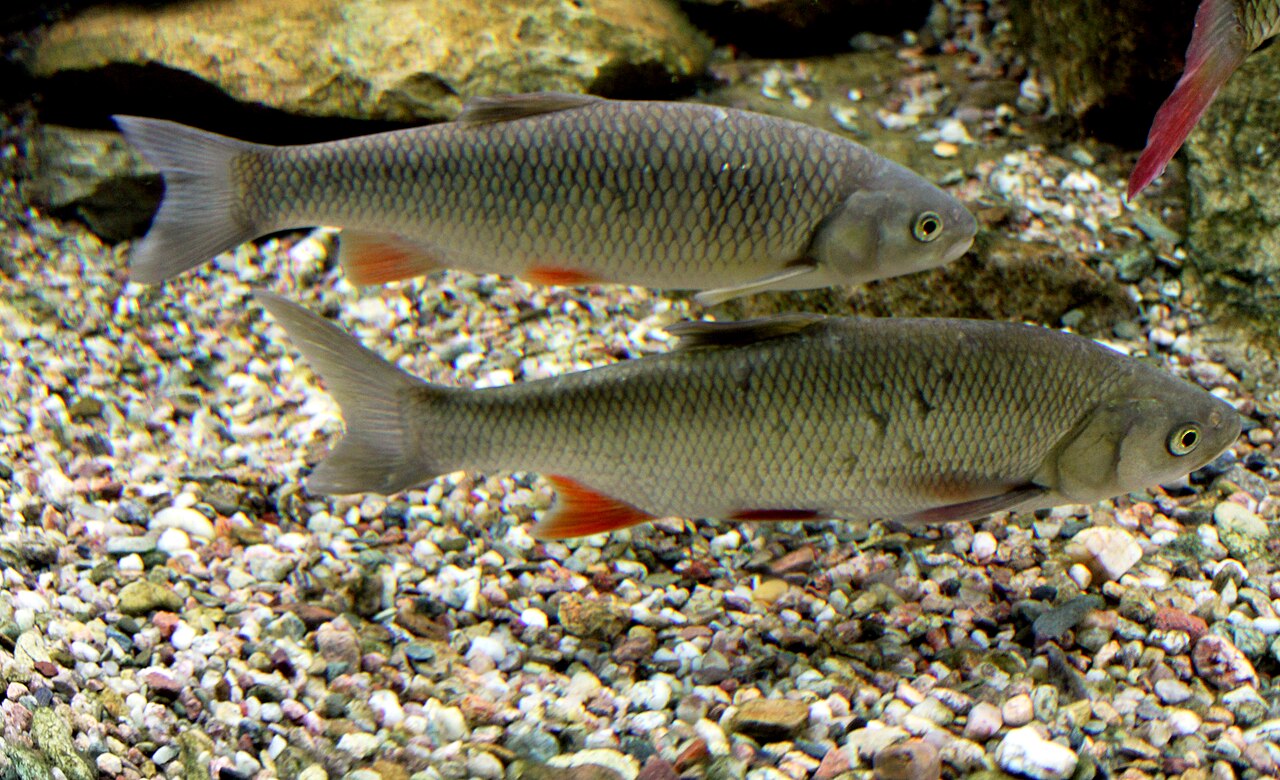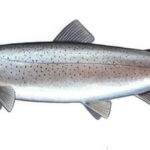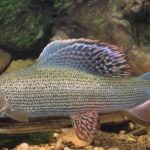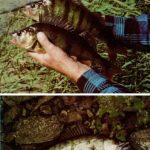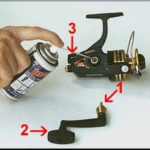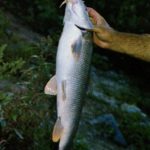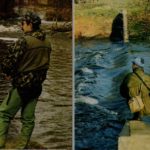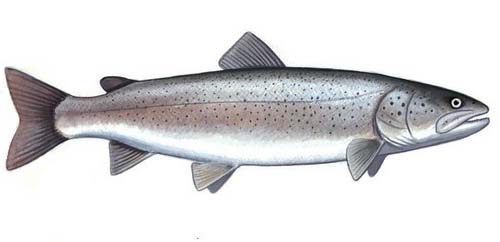 Początek zimy, to nad górskimi wodami, czas ciszy i spokoju. Skończyły się jesienne najazdy spławikowców i gruntowców, sporadycznie spotkać można zabłąkanego muszkarza szukającego kapryśnego, zimowego lipienia.
Początek zimy, to nad górskimi wodami, czas ciszy i spokoju. Skończyły się jesienne najazdy spławikowców i gruntowców, sporadycznie spotkać można zabłąkanego muszkarza szukającego kapryśnego, zimowego lipienia.
Także ryby, przygotowując się do zimowania zapadły w głębokie doły i…..z rzadka tylko manifestują swą obecność żerowaniem powierzchniowym.
Jest jednak ryba, która przyciąga magnetyczną wręcz siłą wąskie grono zapaleńców, którzy nie bacząc na mróz i śnieg, drepczą po kamienistych brzegach Dunajca czy Popradu w jej poszukiwaniu. To głowacica, legendarna Królowa Podhala. Ryba, wokół której narosło wiele mitów odnośnie doboru sprzętu, cudownych, jedynie skutecznych przynęt, pór żerowania i jej niebywałej, wręcz mamuciej siły i rozmiarów do jakich dorasta. Niestety, praktyka wykazała, że „złoty środek” na jej złowienie po prostu nie istnieje. Jedyny sposób na zbliżenie się do sukcesu to być i jeszcze raz być nad wodą o każdej porze dnia i w każdych warunkach pogodowych, co i tak zresztą nie gwarantuje powodzenia. Potwierdzają to wyniki specjalistów w jej połowie, którzy rozkłady rzędu trzech, czterech i więcej ryb w sezonie muszą często okupić kilkudziesięcioma dniami ciężkiej katorgi ze spinningiem w ręku.
Co ma jednak począć początkujący łowca, który mimo tych trudności zapragnie zmierzyć się z głowacicą?
Powinien, przede wszystkim, uzbroić się w odpowiedni sprzęt, a więc mocne wędzisko, kołowrotek z niezawodnym mechanizmem hamulca i przekładnią, przesmarowany (ważne!) nie tężejącym na mrozie smarem. Bardzo ważny jest dobór odpowiednio mocnej żyłki, myślę że 0,40 mm nie będzie przesadą z uwagi na niskie temperatury i fakt, iż łowimy ciężkimi przynętami, których bezwładność podczas wyrzutów powoduje ciągłe zaciskanie węzła łączącego żyłkę z agrafką, co po kilkudziesięciu rzutach poważnie obniża jej wytrzymałość.
Dobór przynęt to osobne zagadnienie, i sądzę, że każdy wędkarz ma swój własny pogląd na tę sprawę.
Niewątpliwie najskuteczniejsze o tej porze roku są średnie i duże woblery, w kolorach srebrnych, imitujące klenie, ukleje i jelce oraz brunatno-złotych odpowiadające ubarwieniu brzanki, ulubionego pokarmu „głowatki”.
Z wielkością woblera nie warto przesadzać, zarówno w jedną jak i drugą stronę. Zbyt mały może pozostać niezauważony lub zlekceważony, przy zbyt dużym mogą wystąpić kłopoty z zacięciem. Dobre woblery głowacicowe bez względu na ich konstrukcję czy wygląd zewnętrzny łączy jedna wspólna cecha, tj. stabilna praca w warunkach silnego i zmiennego prądu wody.
W większości przypadków wystarczą woblery pływające, którym w zależności od ustawienia steru jesteśmy w stanie skutecznie obłowić praktycznie każde miejsce.
Zresztą, głębokie „oranie” dołów w poszukiwaniu głowacicy nieczęsto przynosi efekt, gdyż ta żerując patroluje wszelkie wypłycenia, załamania nurtu na granicy strugi, rafy, czyli te miejsca, gdzie jej potencjalne ofiary starają się ukryć w trakcie jej żerowania.
Nie warto również łowić godzinami w jednym, nawet najlepszym miejscu. Głowacica gdy bierze, czyni to zazwyczaj w pierwszych kilku, kilkunastu rzutach. Na nic zdaje się prowokowanie jej do brania ciągłym podawaniem przynęty w obszar domniemanego czy znanego stanowiska, co okazuje sę skuteczne podczas łowienia innych drapieżników. Dobrze jest natomiast, po obłowieniu danego miejsca woblerem, zmienić przynętę na np. wahadłówkę, zapomnianą już klamkę czy dużą obrotówkę.
Gdzie i kiedy jej szukać?
Jeżeli chodzi o porę dnia, to brań spodziewać się możemy przez cały dzień ze szczególnym uwzględnieniem czasu świtu i zmierzchu. Późną jesienią i na początku zimy głowacice zajmują typowe miejsca – zimowiska ryb spokojnego żeru, które opuszcza-
ją swe letnie rewiry szukając miejsc ze spokojną, głęboką wodą. I właśnie tam, na granicy płytkich wlotów czai się głowacica polując na migrujące ryby. Krytycznym momentem w połowie głowacicy jest chwila brania i zacięcie. Niezmiernie rzadko branie odczuwamy jako potężne uderzenie, częściej jest to po prostu miękkie przytrzymanie, dla niewprawnych trudne do odróżnienia od zaczepu. Mniej opanowani w każdym przypadku wykonują mocne zacięcie, narażając się na utratę przynęt, a nawet złamanie wędki. Inni czekają na pierwsze „bujnięcia” głowacicy z przynętą w pysku, dopuszczając jednak do utraty części biorących ryb w wyniku zbyt późnego zacięcia.
Gdy już uda nam się skutecznie zaciąć, podstawową zasadą podczas holu jest spokój i opanowanie, gdyż głowacica walczy w toni często przy powierzchni, niezbyt dynamicznie, dysponując jednak ogromną siłą.
Po niespiesznym sprowadzeniu ryby na płyciznę trzeba być przygotowanym na jej ostatni zryw. Rybę podejmujemy z wody chwytem pod pokrywy skrzelowe, nie radzę stosować chwytów „łososiowych” tj. za nasadę ogona, gdyż wszelkie tego typu kombinacje kończą się zazwyczaj gwałtowną reakcją ryby.
Na koniec ciekawostka.
Bywa, że po skończonym żerowaniu, jedna lub kilka sztuk zaczyna się spławiać, często hałaśliwie wykonując przy tym akrobacje na kształt delfinich skoków. Starzy wędkarze stwierdzają wtedy, że „głowatki kąpią się”.
Dla niewtajemniczonych ten głowacicowy balet sprawiać może wrażenie intensywnego żerowania. Nic bardziej błędnego! Osobiście nie słyszałem, by ktoś złowił głowacicę podczas ich „kąpieli”. Mnie natomiast nie zdarzyło się wtedy nie wykonać chociażby kilku rzutów, jak dotąd bez efektów.
